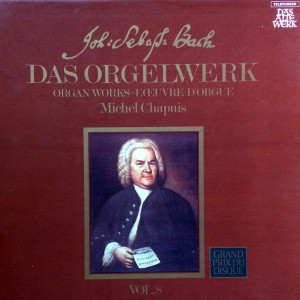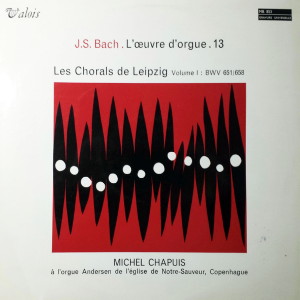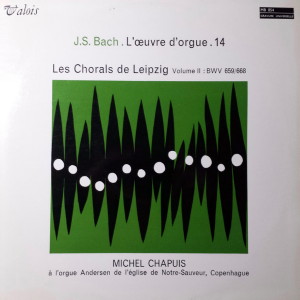 |
|
2 LP's
- BC 25105-T/1-2 - (p) 1966
|

|
| 1 LP -
Valois MB 853 - (p) 1966 |
 |
| 1 LP -
Valois MB 854 - (p) 1966 |
|
| DAS ORGELWERK -
VOL. 8 |
|
|
|
|
|
Johann
Sebastian Bach (1685-1750) - Achtzen
Choräle von verschiedener Art
(Leipziger Choräle)
|
|
|
|
|
|
| Long Playing
1 - (Valois MB 853) |
|
|
| Fantasia super:
Komm, heiliger Geist, Herre Gott,
BWV 651 |
4' 23" |
|
| Komm, heiliger
Geist, Herre Gott (alio modo),
BWV 652 |
7' 32" |
|
| An
Wasserflüssen Babylon, BWV 653 |
4' 48" |
|
| Schmücke
dich, o liebe Seele, BWV 654 |
6' 28" |
|
|
|
|
| Trio
super: Herr Jesu Christ, dich zu
uns wend', BWV 655 |
3' 37" |
|
| O
Lamm Gottes unschuldig, BWV
656 |
8' 25" |
|
| Nun
danket alle Gott, BWV 657 |
4' 05" |
|
| Von
Gott will ich nicht lassen,
BWV 658 |
3' 10" |
|
Long Playing
2 - (Valois MB 854)
|
|
|
| Nun
komm' der Heiden Heiland,
BWV 659 |
3' 39" |
|
| Trio
super: Nun komm' der Heiden
Heiland, BWV 660 |
2' 40" |
|
| Nun
komm' der Heiden Heiland,
BWV 661 |
2' 20" |
|
| Allein
Gott der Höh' sei ehr',
BWV 662 |
6' 15" |
|
| Allein
Gott der Höh' sei ehr',
BWV 663 |
6' 10" |
|
|
|
|
| Trio
super: Allein Gott der Höh' sei
ehr', BWV 664 |
4' 15" |
|
| Jesus
Christus, unser Heiland, BWV
665 |
3' 17" |
|
| Jesus
Christus, unser Heiland (alio
modo), BWV 666 |
2' 33" |
|
| Komm,
Gott Schöpfer, Heiliger Geist,
BWV 667 |
1' 45" |
|
| Wenn
wir in höchsten Nöten sein,
BWV 668a |
4' 03" |
|
|
|
|
| Michel Chapuis |
|
an
der Andersen-Orgel der
Erlöser-Kirche, Kopenhagen
|
|
|
|
|
|
Luogo
e data di registrazione |
|
Kopenhagen
(Danimarca) - agosto 1966 |
|
|
Registrazione: live /
studio |
|
studio |
|
|
Producer / Engineer |
|
Michael
Bernstein |
|
|
Prima Edizione LP |
|
- Valois
- MB 853 · Vol. 13 - (1 LP) -
durata 42' 28" - (p) 1966 -
Analogico
- Valois - MB 854 · Vol. 14 - (1
LP) - durata 36' 57" - (p) 1966 -
Analogico
|
|
|
"Das Orgelwerke" LP |
|
Telefunken
- BC 25105-T/1-2 - (2 LP's) -
durata 42' 28" / 36' 57" - (p)
1966 - Analogico |
|
|
Note |
|
- |
|
|
|
|
|
The eighteen
chorale arrangements
combined here owe their fame
initially to the fact that
in the last years of his
life Bach collated them in a
calligraphically ordered
volume in the still vacant
section of his manuscript
where, towards the end of
the 1720’s
he had already entered his
six organ sonatas. This
distinction was even
intensified by hypotheses
verging on the biographical
built up around the pieces
at the end of this
collection, and in
particular the last one.
With very little imagination
the style of the entries can
easily be connected with
Bach’s illness, his brief
recovery and final
blindness: towards the
conclusion the entries were
evidently often interrupted
for long periods. The 16th
and 17th pieces were not
written by Bach himself, but
by his son-in-law
Altnickol. Following these,
once more in Bach’s own
hand, are the “Kanonische
Veranderungen über
das Weihnachts-Lied: Vom
Himmel hoch, da komm ich
her” (Canonic Variations on
the Christmas Carol: Vom
Himmel hoch, da komm ich
her). As a five-part work,
also published in printed
form, this breaks with the
character of the collection
and thus is not included as
far as the “Eighteen
Chorales” are concerned.
The conclusion, written in
another’s handwriting, is
formed by the funeral
chorale. “Vor deinen Thron
tret ich hiermit”, which,
under the older title “Wenn
wir in höchsten
Nöten
sein”, is the final piece in
the “Art of the Fugue”
printed after Bach’s death.
It takes the place there of
the unfinished quadruple
fugue. The appropriate
“report” on this says that
Bach “in his blindness
dictated it to the pen of
one of his friends”. Johann
Nikolaus Forkel, the Bach
biographer, is even more
precise: “In his blindness,
a few days before his end,
Bach dictated it to the pen
of his son-in-law
Altnickol”. It is not
surprising that as a result
of this report the idea
arose that the last entry in
our collected manuscripts
was his deathbed statement.
Even though we are now aware
that the writer of this
piece was not Altnickol but
an unknown helper from
Bach’s very last years,
speculations about the
biographical significance of
this piece have not ceased.
More about this later. As
the last musical testimony
of somebody preparing for
death, this chorale finally
left its mark on the entire
collection: it is more and
more considered on the whole
as a testamentary legacy,
comparable with the Art of
the Fugue, with the first
printing of which it is
connected by way of the last
chorale. The pieces
themselves perhaps justify
such parallels from the
artistic point of view, but
not as regards stylistic
considerations. All of
them go back as far as
Bach’s Weimar period and
were therefore composed
fairly early. They also
display varying degrees of
ability. For the fair copy
Bach corrected them in
parts, completely rearranged
a few of them, but in many
cases also used them
practically unchanged. When
he began the entries the
whole undertaking was also
probably envisaged as more a
loosely arranged collection.
The impetus for this might
initially have been of an
external nature; for
instance, perhaps the old
manuscripts had become
unuseable from frequent
reference and countless
corrections, and were now to
be replaced, for which the
empty pages of the sonata
manuscript paper were
available. No definite
principle can be discerned
in selection and sequences,
such as from a liturgical,
formal or stylistic point of
view. There is no common
title which might provide
further details. It also
seems as if the contents
were not laid down from the
outset, and that at least
inclusion of the two last
pieces, the “Canonic
Variations” and the funeral
chorale, was due more to a
snap decision than to a
preconceived plan.
But how ever the collection
might have been compiled, it
provides a survey of the
various forms of Bach’s
chorale arrangements which
could hardly have had a more
penetrating and significant
effect. All that are missing
are examples of the “minor”
organ chorales. Two,
however, Nos. 17 and 18,
originated from such
chorales without episodes in
the Orgelbüchlein.
The canonic technique is
also missing - except of
course for the “Canonic
Variations”, which have been
raised to the status of a
principle. Six pieces (3, 4,
9, 10, 12, 13) expose the
chorale melody in coloured
form in the discant and in
the tenor. Three (2, 7, 18)
precede each chorale line
with detailed preimitations
and thus adhere to the
oldest and most common type
of the “great” organ
chorales. Nos. 1 and 11 are
extended fantasies with the
chorale in the bass. In
addition there are two trio
movements (5 and 14) which
resolve the chorale melody
in brilliant figuration and
are equal to the fiery style
of the concertante allegro
movements of the organ
sonatas. Five pieces are in
singular form. As regards
two chorale melodies, there
are two different
arrangements for each, and
for two further,
particularly well-known,
melodies, even three for
each. Most of the settings,
but not all of them, are
intended for performance on
two pianos and pedal. With
its forms linked to the
melody, the collection at
any rate provides an
important counterpart to the
free trio movements which
make up the first part of
the overall volume.
Fantasia super “Komm,
heiliger Geist”, BWV 651.
The imitative upper part
setting organo pleno starts
with toccata-style emphasis
above the pedal point and
does not permit the powerful
semi-quaver movement to
settle down. It is
determined by a single
figuration subject and it
appears as if it is purely
by coincidence bound to the
chorale foundation, rendered
line by line in the pedal.
In the Weimar version the
piece was limited to the
first four of the total of
eight chorale lines, and the
alleluia conclusion is also
missing. Because of the
identical chorale lines,
Bach was able to take over
for the second section the
upper voice part of the
first, and needed to compose
only a fresh episode and the
alleluia conclusion. This
extension by more than
double, with retention of
the same motif, makes heavy
demands upon the performer,
who has to intensify the
impact of this movement
right to the end.
Komm, heiliger Geist,
alio modo, BWV 652. In
this case the same chorale
melody is set in saraband
rhythm in regular sequence
(tenor-alto-pedal-bass-discant)
and imitatively in the same
mensuration. A change comes
only with the alleluia
conclusion. Bach leaves the
early composition
substantially unchanged, but
merely for reasons of
modulation inserts a measure
in each of the individual
line expositions.
An Wasserflüssen
Babylon, BWV 653.
While still in Weimar Bach
changed the five-part
original version (BWV 653
b), which uses the double
pedal, to four-part form.
This was recorded in Series
V of the Organ Works. He
attached for the Leipzig
fair copy the ascending
finale. The superior art of
this famous movement is
apparent from the
contrapuntal interlinking of
the individual line melodies
in the preimitations. The
cantus firmus is in the
tenor.
Schmücke
dich, o liebe Seele, BWV
654 brings the
ornamented chorale melody in
the soprano, but otherwise
is arranged similarly to the
previous setting, which it
equals in fame. Bach needed
to change hardly anything
subsequently in the Weimar
setting.
In the trio on “Herr Jesu
Christ, dich zu uns wend’
”, BWV 655, the
chorale is reserved for the
conclusion. It begins like
the allegro of a trio sonata
with a concerto-style theme,
found in similar form in the
Triple Concerto A minor (BWV
1044). The final entry of
the chorale is coupled with
the reappearance of the
first theme in the upper
part, and by way
of this reprise effect
emphasizes the concerto-type
construction of the
movement. Here too the
Weimar version is for the
greater part unchanged.
O Lamm Gottes,
unschuldig, BWV 656.
In the three verses,
composed as an entity, the
cantus firmus descends from
the soprano via the alto
into the pedal, which does
not join in until the third
verse. At the same time the
movement structure tightens
and achieves graphic
expression with the chorale
lines “All Sünd
hast du getragen, sonst müssten
wir verzagen”. The Leipzig
rearrangement initially
affects the second verse.
Nun danket alle Gott, BWV
657. The chorale lines
in the discant are preceded
in the other parts by
detailed preimitations in
shortened mensuration which,
together with the firmly
moving principal subject in
crotchets, dominate the
solid expression of the
movement. The piece was
taken over unchanged in the
Leipzig collection.
Von Gott will ich nicht
lassen, BWV 658
surpasses the other pieces
in its manifest gestures:
the upper part section,
which rises above the cantus
firmus in the pedal, is
dominated by a scalar motif
striving into the higher
pitches. In the ostinato
repetitions of the final
measures it takes on
absolutely entreating force.
In
the Weimar version, which
varies from the Leipzig only
due to some minor
ornamentation, the piece is
described as a “Fantasy”.
Nun komm, der Heiden
Heiland, BWV 659. The
entire expression here is
placed in the figuration of
the upper parts which bears
the cantus firmus. The
middle parts, which begin
imitatively, provide the
light and shadow, the
striding bass, tranquility
and security. The Weimar
version, like that of the
previous piece, entitled
“Fantasy”, deviates from the
Leipzig version only to a
minor degree.
In the Trio super “Nun
komm, der Heiden Heiland”,
BWV 660 the ornamented
chorale part rises freely
above the duet of the two
imitative bass voices, which
in part are also carried in
strictly canonic style and
which, with their descending
staircase effect, seem to
indicate the concept of
“coming down”. Here, too,
very little has been changed
in the Leipzig version.
Nun komm, der Heiden
Heiland, BWV 661. This
third arrangement of the
advent hymn, for organo
pleno, emphasizes the
festive character of the
advent period. The upper
parts form from the
figuration of the chorale
theme a three-part fugue,
which is joined in the
various parts by the cantus
firmus in the pedal. It is
not clear why Bach scored
precisely this concertante
setting in the Leipzig
manuscript vis-a-vis the
Weimar version in double
note values.
Allein Gott in der Höh’
sei Ehr’, BWV 662. The
movement entitled “adagio”
intensifies the principle of
ornamentation. The cantus
firmus part, which lies in
the soprano, takes up the
melodic impulse of the two
middle voices which enter
earlier and also relate to
the chorale melody. At the
beginning of the bar section
the supporting bass for a
short while goes into the
unornamented chorale line. -
Very little was amended for
the Leipzig fair copy.
Allein Gott in der Höh’
sei Ehr’, BWV 663 with
the cantus firmus in the
tenor, as expressly stated.
With the two preimitated
upper parts this forms a
unified trio movement in
that it adapts the chorale
melody by way of
ornamentation to the
continuous quaver movement.
The bass in turn takes part
with long note values in the
preimitation, so that one
might at first take this to
be the cantus firmus part. -
Once again the Weimar
version has been used almost
unchanged in the fair copy.
The Trio super “Allein
Gott in der Höh’
sei Ehr”’, BWV 664,
the third setting of this
hymn of glory, is related to
the other concertante trio
movement, the fifth piece in
this collection, but is more
freely arranged than the
former. It also saves the
chorale cantus firmus to the
end, and then even contents
itself with the first two
lines.
Here also the Weimar
versions, of which there are
two, are only little
different from the Leipzig
pieces.
Jesus
Christus, unser Heiland,
BWV 665, is at first
set in an allemande rhythm.
The chorale melody is in the
pedal. The other parts
provide pre-
and post-imitations,
combined with figurative
counterpoint. With their
assistance, according to the
principle of harmonic
condensation and stimulated
intensification, four
characteristically varying
sections are formed from the
four chorale lines. - The
Weimar versions are
practically unchanged.
The setting of “Jesus
Christus, unser Heiland”
alio modo, BWV 666, in
the rhythm of the gigue and
with the cantus firmus in
the discant, is arranged in
two parts. After the second
chorale line the figuration
of the counterpointing parts
moves from quavers to semi-quavers,
and this mobility is
maintained until the end. -
Only little had to be
changed in this case for the
Leipzig fair copy which,
like that of the following
piece, was written by
Altnickol.
Komm, Gott Schöpfer,
Heiliger Geist, BWV 667.
The small chorale from the
“Orgelbüchlein”,
with the chorale in the
soprano, was extended by
Bach in Weimar by a second
verse containing episodes.
The chorale melody here is
in the bass. The
counterpointing upper voices
take up the semi-quaver
movement of the original
concluding passage and form
a toccata-type
superstructure. - After the
Canonic Variations on “Vom
Himmel hoch” (BWV 769),
already included in Series
II of this sequence of
recordings, the last piece,
written by an unknown
assistant, from Bach’s final
period, is the chorale “Vor
deinen Thron tret ich
hiermit”, BWV 668. The
manuscript has come down to
us in only fragmentary form
- the last page containing
the conclusion has been
lost. It is complete only in
the printed copy of the “Art
of the Fugue", where it
appears under the older
title: “Wenn wir in höchsten
Nöten
sein”, BWV 668 a. This
last piece is also based on
a chorale from the Orgelbüchlein.
However, as opposed to the
17th piece, Bach has here
more widely separated the
individual lines of the
original setting by artistic
preludes and episodes, with
imitations in even and
counter movement, in
shortened and unabbreviated
mensuration. He simplified
the hitherto strongly
ornamented chorale melody in
the upper voice. Friedrich
Smend pointed out that in
this form the chorale
accounts for 14 notes for
the first line and 41 for
the entire setting.
According to the numerical
alphabet (A = 1, B = 2
etc.), this means “Bach” and
“J.
S. Bach”, who was now
preparing for the last
journey.
by Georg
von Dadelsen
English
translation by
Frederick A. Bishop
This critical
and complete stylistic
survey of Bach's
organ works is
the eighth
part
and will be
continued by
further
releases.
|
|
|
Johann
Sebastian Bach - DAS
ORGELWERK
|
|
|
|

